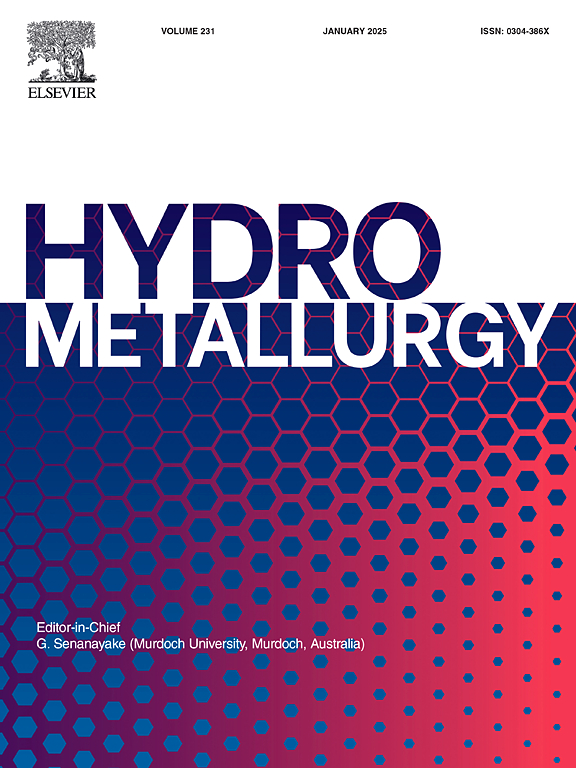采用过硫酸盐、催化剂和自由基为基础的高级氧化工艺对难处理金矿进行高效预处理,以提高氰化效果
IF 4.8
2区 材料科学
Q1 METALLURGY & METALLURGICAL ENGINEERING
引用次数: 0
摘要
从难选矿石中提取金(Au)是一项重大挑战,因为硫化矿物中含有金颗粒。研究了一种可替代的、高效氧化预处理难处理金矿石和精矿的过硫酸盐基高级氧化工艺。这种方法产生强大的氧化自由基,氧化硫化矿物,从而释放出封闭的金。对所研究的金精矿,直接氰化提金收率仅为62.6%。利用自动扫描电子显微镜(SEM)和能量色散x射线(EDX)对这种表现背后的难熔性行为进行了诊断浸出和矿物学表征,并将其归因于硫铁矿和毒砂等硫化物矿物中金的细颗粒包裹。为了用过硫酸盐氧化这些硫化物,研究了四种活化模式:紫外(UV)活化、超声(US)活化、热(T)活化和Ag+和Fe2+催化剂。实验结果表明,UV法和US法生成活性自由基的效率更高,对Fe、As和S的去除效率以及随后氰化提金的效率依次为:UV法和US法;我们比;T比;Ag) +比;价。利用苯酚和硝基苯化学探针鉴定黄铁矿和毒砂的氧化自由基主要是硫酸盐自由基(SO4•−)和羟基自由基(OH•)。这些自由基通过UV和US激活模式更有效地产生。美国活化的金提取率为86.4%,而紫外线活化的金提取率略高,为88.1%。研究结果还表明,UV与Ag+催化剂、US在80℃下加热、US在80℃下加热、Ag+催化剂存在下,金的提取率分别为91.1%、92.2%和93.6%。研究结果提出了硫化矿物在预处理过程中氧化的可能机制。本文章由计算机程序翻译,如有差异,请以英文原文为准。

Highly efficient pretreatment for refractory gold ores using persulfate, catalyst and free radical based advanced oxidation processes to improve cyanidation
The extraction of gold (Au) from refractory ores poses major challenges due to the inclusion of gold particles in sulfide minerals. In this study, an alternative and highly efficient oxidative pretreatment for refractory gold ores and concentrates was developed using persulfate-based advanced oxidation process. This approach generates strong oxidizing radicals to oxidize sulfide minerals, thereby releasing the enclosed gold. For the studied gold concentrate, the extraction of gold by direct cyanidation reached only a yield of 62.6 %. The refractoriness behavior behind this performance has been examined using diagnostic leaching and mineralogical characterization using automated Scanning Electron Microscope (SEM) coupled with Energy Dispersive X-ray (EDX), and it was attributed to encapsulation of fine particles of gold within sulfide minerals mainly pyrite and arsenopyrite. To oxidize these sulfides by persulfate, four activation modes were examined to generate reactive radicals: ultraviolet (UV) activation, ultrasound (US) activation, thermal (T) activation and Ag+ and Fe2+ catalysts. The experimental results showed that UV and US methods are more efficient in generating reactive radicals, and the removal efficiency of Fe, As and S as well as the subsequent gold extraction by cyanidation varied in the following order: UV > US > T > Ag+ > Fe2+. The identification tests via utilization of phenol and nitrobenzene chemical probes revealed that the oxidizing radicals predominant and responsible for the oxidation of pyrite and arsenopyrite are sulfate radicals () and hydroxyl radicals (OH•). These radicals are generated more effectively through UV and US activation modes. The US activation resulted in a gold extraction of 86.4 %, while UV activation achieved a slightly higher extraction of 88.1 %. The findings showed also that combining UV with Ag+ catalyst, US with heating at 80 °C, and US with heating at 80 °C in the presence of an Ag+ catalyst resulted in gold extractions of 91.1 %, 92.2 %, and 93.6 %, respectively. The results led to proposing a possible mechanism for the oxidation of sulfide minerals during the pretreatment process.
求助全文
通过发布文献求助,成功后即可免费获取论文全文。
去求助
来源期刊

Hydrometallurgy
工程技术-冶金工程
CiteScore
9.50
自引率
6.40%
发文量
144
审稿时长
3.4 months
期刊介绍:
Hydrometallurgy aims to compile studies on novel processes, process design, chemistry, modelling, control, economics and interfaces between unit operations, and to provide a forum for discussions on case histories and operational difficulties.
Topics covered include: leaching of metal values by chemical reagents or bacterial action at ambient or elevated pressures and temperatures; separation of solids from leach liquors; removal of impurities and recovery of metal values by precipitation, ion exchange, solvent extraction, gaseous reduction, cementation, electro-winning and electro-refining; pre-treatment of ores by roasting or chemical treatments such as halogenation or reduction; recycling of reagents and treatment of effluents.
 求助内容:
求助内容: 应助结果提醒方式:
应助结果提醒方式:


